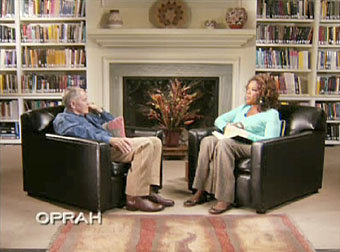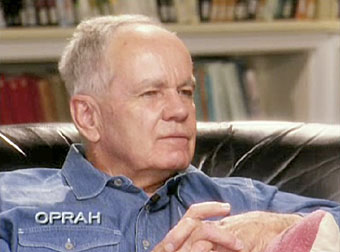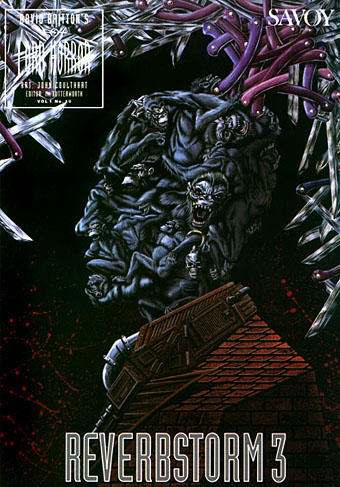A sketch of James Joyce from 1994.
Tag: James Joyce
Cormac and Oprah
Cormac McCarthy’s appearance on Oprah’s Book Club—his first television appearance ever—was screened last week. You can watch it online for free on her site although you need to register first. The interview is presented in chunks and only lasts for about twenty minutes but it was worthwhile for all that, even if it is chopped to pieces in that manner typical of American daytime TV.
Most of the discussion skated on the surface but I was surprised (and pleased) when Oprah mentioned having read several of his books, including his ferocious masterwork, Blood Meridian. Main topic was The Road, of course, but we also got to hear something about Cormac’s dedicating himself to a life of precarious unemployment in order to have the freedom to write. He’s playing my tune but I imagine many of Oprah’s viewers would have struggled to comprehend that decision. Faulkner’s name was mentioned, and James Joyce when they talked about the lack of punctuation in his prose. In the end it was enough to simply see the man as a human being sat in a chair. And kudos again to Oprah for championing his work.
Meanwhile, The Sopranos screened its final episode on Sunday night. I watched the last couple of seasons via BitTorrent so I’m privy to the controversial ending which I won’t reveal here even though plenty of news sites have done so already. All I’ll say is I approve of the ending and regard the naysayers as foolish in complaining about a series which throughout its run tried to be different, challenging and better than the half-baked fare which is usually offered as television drama. For those who know the ending (or aren’t so concerned about it), series creator David Chase discussed his intentions and the audience reaction with the New Jersey Star-Ledger.
Update: A David Chase comment from 2001 turned up via the NYT. I’m sure these are sentiments Cormac McCarthy would also agree with.
What’s the difference between what’s art and what isn’t art? That’s the hard question to answer. The only thing that I guess I believe is that a lot of what I see on the air and in other places is giving answers, and I don’t think art should give answers. I think art should only pose questions. And art should not fill in blanks for people, or I think that’s what’s called propaganda. I think art should only raise questions, a lot of which may be even dissonant and you don’t even know you’re being asked a question, but that it creates some kind of tension inside you.
Previously on { feuilleton }
• In praise of Cormac
• Cormac McCarthy book covers
My pastiches
Lord Horror: Reverbstorm #3 (1992).
Following from the post about an art forgery exhibition (and Eddie Campbell discussing his American Gothic cover for Bacchus), I thought I’d post some of my own forgeries, or pastiches as we call them when no deception is intended.
Reverbstorm was the Lord Horror comic series I was creating with David Britton for Savoy in the 1990s. The Modernist techniques of collage (as in the work of Picasso and others) and quotation (as in TS Eliot’s The Waste Land) became themes in themselves as the series developed, so it seemed natural to imitate the styles of various artists as we went along. Pastiche is also a chance to flagrantly show off, of course, and I can’t deny that this was also one of my impulses here.
Issue #3 of Reverbstorm had marauding apes as its theme, from the Rue Morgue to Tarzan and King Kong, so I had the idea of doing an ape cover in the style of the celebrated paintings by Giuseppe Arcimboldo (1527–1593) which make human heads out of fruit, flowers or animals. Easy enough to have the idea but making it work took a lot of effort and required careful sketching beforehand, something I rarely do. The painting was gouache on board, a medium I’d been using for years and this was about the last gouache work I did before switching to acrylics.
T&H: At the Sign of the Dolphin

James Joyce and his World (1978).
 Despite my earlier statement about not being much of a collector, today’s book purchase (above) was enough to confirm some well-established patterns (obsessions, even) that should make me reconsider any hasty pronouncements. Not so much for the subject in this case—I already have enough books by and about James Joyce—the significant thing here is the three magic words on the cover: Thames and Hudson. The sight of Joyce’s name on the spine above the old T&H dolphin logo (signifying the two rivers that comprise the company’s name; or maybe a discourse between London and New York via the Atlantic) was enough to demand further investigation. I realised I’d been hoping to eventually find this book after seeing it listed in the back of its companion title, Beardsley and his World by Brigid Brophy. Both books form part of a series that T&H produced in the Seventies, a collection of heavily illustrated mini-biographies of writers, with the odd artist among them. Very worthwhile they are too, with lots of photographs, paintings or drawings of the people and places relevant to their subjects’ lives.
Despite my earlier statement about not being much of a collector, today’s book purchase (above) was enough to confirm some well-established patterns (obsessions, even) that should make me reconsider any hasty pronouncements. Not so much for the subject in this case—I already have enough books by and about James Joyce—the significant thing here is the three magic words on the cover: Thames and Hudson. The sight of Joyce’s name on the spine above the old T&H dolphin logo (signifying the two rivers that comprise the company’s name; or maybe a discourse between London and New York via the Atlantic) was enough to demand further investigation. I realised I’d been hoping to eventually find this book after seeing it listed in the back of its companion title, Beardsley and his World by Brigid Brophy. Both books form part of a series that T&H produced in the Seventies, a collection of heavily illustrated mini-biographies of writers, with the odd artist among them. Very worthwhile they are too, with lots of photographs, paintings or drawings of the people and places relevant to their subjects’ lives.
A wake for Arthur
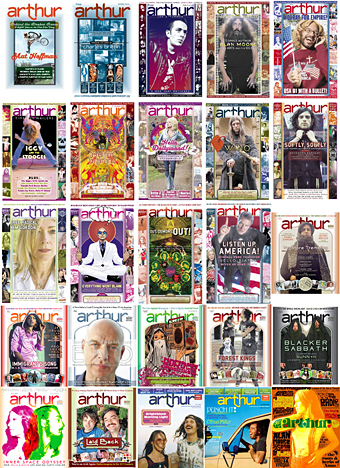
That which you will miss: Arthur #1–25.
“And till Arthur comes againus and sen peatrick’s he’s reformed we’ll pose him together a piece, a pace.” Finnegans Wake by James Joyce.
Awake, A Wake!
Come celebrate the happy, all-too-brief life of Arthur Magazine with free giveaways and a reading featuring Molly Frances, Oliver Hall, and Peter Relic.
Thursday, March 1, 7:30pm
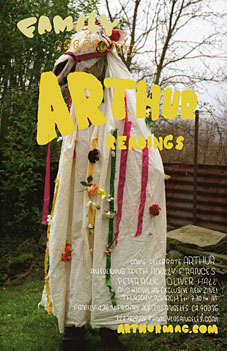 Family Bookstore, 436 N. Fairfax Avenue (across the street from Canter’s Deli), Los Angeles, 90036.
Family Bookstore, 436 N. Fairfax Avenue (across the street from Canter’s Deli), Los Angeles, 90036.
Arthur‘s “New Herbalist” columnist Molly Frances incited a revolution nationwide by informing readers of the true powers of almonds, sprigs of mint, and Lord Byron’s secret potion (a.k.a. apple cider vinegar). Molly’s eerily prescient horoscopes have been known to strike the melodic funny-bone of even the most determined non-believer. Tonight Molly will be giving astrological readings as well tripling any double entendre at hand.
Oliver Hall penned Arthur‘s cover story on Kim Gordon and memorably profiled folk radicals Faun Fables. He is the statuesque guitarist with L.A.’s newest psych-rock sensation E.S.P.S., and is seldom seen without his trusty Patsy Cline t-shirt. Tonight Hall will be dispensing priceless aphorisms as well as deconstructing the pungent, multi-faceted phrase “no money, no honey.”
Peter Relic eulogized Jam Master Jay and went on the road with the Black Keys and Sleater-Kinney for Arthur. Relic’s profile of the Geto Boys, reprinted in Da Capo’s Best American Music Writing 2006, was deemed by Seattle’s The Stranger to be “easily one of the most surreal, violent, and ludicrous artists encounters ever documented.” Tonight Relic will be reading from his storehouse of pantoums, an unjustly obscure Malaysian poetic form.
We look forward to seeing you there—dressing in black not a requirement!
Update: Village Voice post-mortem.


